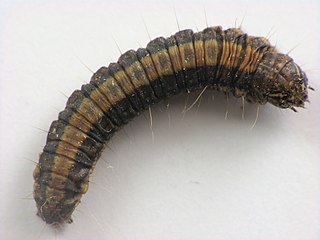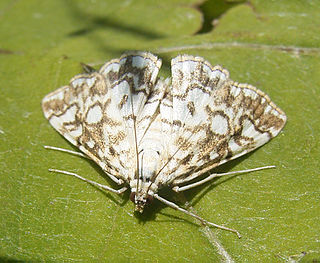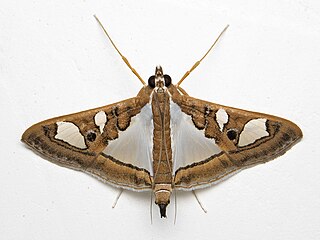
Pyraustinae is a large subfamily of the lepidopteran family Crambidae, the crambid snout moths. It currently includes over 1,400 species; most of them tropical but some found in temperate regions including both North America and Europe.

Spilomelinae is a very species-rich subfamily of the lepidopteran family Crambidae, the crambid snout moths. With 4,132 described species in 340 genera worldwide, it is the most speciose group among pyraloids.

Achyra affinitalis, the cotton web spinner, is a moth of the family Crambidae. It was described by Julius Lederer in 1863 and is found in Australia and New Zealand.

Herpetogramma is a genus of moths of the family Crambidae described by Julius Lederer in 1863. It currently comprises 106 species and is found in North America, Eurasia, Australia, New Zealand, Central and South America. Of the few species where host plants are known, the larvae mostly feed on grasses.

Ischnurges is a genus of moths of the family Crambidae.

Phaedropsis is a genus of moths of the family Crambidae.
Stenochora is a genus of moths of the family Crambidae. It contains only one species, Stenochora lancinalis, the lanced pearl, which is found in southern and south-eastern Africa and the African islands of the Indian Ocean. The range includes Botswana, the Comoros, the Democratic Republic of Congo, La Réunion, Madagascar, Mauritius, Mozambique, the Seychelles (Aldabra), South Africa, Tanzania, Zambia and Zimbabwe.

Parotis suralis is a moth of the family Crambidae. The species was first described by Julius Lederer in 1863. It is found around the west Pacific Rim, including the Chagos Islands, Hong Kong, Japan, Kiribati, Tuvalu and the tropical far north of Queensland.

The Chrysauginae are a subfamily of snout moths. They are primarily Neotropical and include about 400 described species.

The Epipaschiinae are a subfamily of snout moths. Almost 600 species are known today, which are found mainly in the tropics and subtropics. Some occur in temperate regions, but the subfamily is apparently completely absent from Europe, at least as native species. A few Epipaschiinae are crop pests that may occasionally become economically significant.

Acentropinae is a fairly small subfamily of the lepidopteran family Crambidae, the crambid snout moths. Species of this subfamily are exclusively found in wetlands and aquatic habitats.
Rhimphalea sceletalis is a small moth in the family Crambidae that is found in Queensland in Australia and in Papua New Guinea. The species was first described by Julius Lederer in 1863.

Glaphyriinae is a subfamily of the lepidopteran family Crambidae. It was described by William Trowbridge Merrifield Forbes in 1923. The subfamily currently comprises 509 species in 75 genera.
Agroterini is a tribe of the species-rich subfamily Spilomelinae in the pyraloid moth family Crambidae. The tribe was erected by Alexandre Noël Charles Acloque in 1897.

Margaroniini is a tribe of the species-rich subfamily Spilomelinae in the pyraloid moth family Crambidae. The tribe was erected by Charles Swinhoe and Everard Charles Cotes in 1889.

Spilomelini is a tribe of the species-rich subfamily Spilomelinae in the pyraloid moth family Crambidae. The tribe was erected by Achille Guenée in 1854.
Steniini is a tribe of the species-rich subfamily Spilomelinae in the pyraloid moth family Crambidae. The tribe was erected by Achille Guenée in 1854.

Nomophilini is a tribe of the species-rich subfamily Spilomelinae in the pyraloid moth family Crambidae. The tribe was erected by Vladimir Ivanovitsch Kuznetzov and Alexandr A. Stekolnikov in 1979.
















